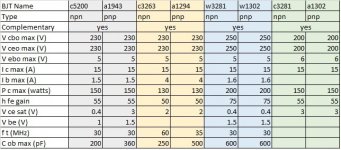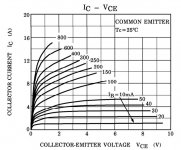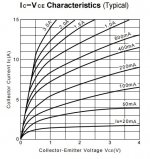Gents, let's discuss the linearity of output transistors, mainly bjt, for power buffer.
Background: I built many amps, and sure can be very happy with quite a few, but recently started experimenting with just buffers. Why? I do not need much power, i have plenty of preamps, and buffers sound much better to me after all.
Maybe its a lack of global negative feedback or something else.
Not interested in starting any flame war about putting shades on mona lisa, creating effect box, or insulting the artist. Fed up with that kind of bs.
I created two fully finished buffers based on c5200/a1943, one based on one output pair, one on three output pairs.
Now i want to experiment with other power bjt for outputs.
I got c3263/a1294.
I got w1302/w3281.
I got w0281/w0302. (I typed it incorrectly)
I hope i typed it correctly. (turns out I did not)
Which of these would be most suitable/linear?
https://www.diyaudio.com/community/threads/direction-of-diodes-in-an-amplifier.379908/page-3
Background: I built many amps, and sure can be very happy with quite a few, but recently started experimenting with just buffers. Why? I do not need much power, i have plenty of preamps, and buffers sound much better to me after all.
Maybe its a lack of global negative feedback or something else.
Not interested in starting any flame war about putting shades on mona lisa, creating effect box, or insulting the artist. Fed up with that kind of bs.
I created two fully finished buffers based on c5200/a1943, one based on one output pair, one on three output pairs.
Now i want to experiment with other power bjt for outputs.
I got c3263/a1294.
I got w1302/w3281.
I got w0281/w0302. (I typed it incorrectly)
I hope i typed it correctly. (turns out I did not)
Which of these would be most suitable/linear?
https://www.diyaudio.com/community/threads/direction-of-diodes-in-an-amplifier.379908/page-3
Last edited:
These appear to be genuine, located in HK.
MOQ: 15 @ $3.37
https://www.win-source.net/hot-sales-and-eol-components-2sc5171.html
MOQ: 150 @ $0.339
https://www.win-source.net/hot-sales-and-eol-components-2sa1930.html
MOQ: 15 @ $3.37
https://www.win-source.net/hot-sales-and-eol-components-2sc5171.html
MOQ: 150 @ $0.339
https://www.win-source.net/hot-sales-and-eol-components-2sa1930.html
It doesn't matter what final trz you're using as long as its driver can charge and discharge quickly its capacitances and that means that the driver is as important as the final transistor. You'll often see a ferrite bead on the base pin of the final trz in Harman Kardon's rather slow power transistors.Old timers used 1X 200MHz 30 watts drivers for 1X 50...60 Mhz 150...200Watts final trz for the lowest distortions as an example.You can also help a slower output and driver trz placing them inside a rail bootstrap keeping it at constant VCE as in Kenwood l-09M.
Last edited:
If you followed the link i provided, i use the same power transistor as driver, identical. Took the idea from fm acoustics.
You could also try the quadrive concept used in kenwood L-A1 where each final trz has its own driver...all these techniques are used to fight the output trz internal capacitances enhancing the slew rate in normsl 2..3EF stages.
Why? I do not need much power, i have plenty of preamps, and buffers sound much better to me after all.
Maybe its a lack of global negative feedback or something else.
Well, you're definitely not the first to say this. I just thought of Charles Hansen, and also Steve Dunlap (the Krill, on this forum). Charles liked the diamond buffer with the same transistors for drivers and outputs iirc.
Also, I just remembered a mod that was once proposed. Say you have a feedback amp with emitter follower output with three pairs of transistors. You would take feedback from only the "first" pair, and break the trace right there (disconnect the speaker from this first pair). The other two pairs are running open loop and these drive the speaker.
Alexandre, i have seen web page with someone designing his own aplifiers just like you describe. I will try to find it, but it may be gone, it was while ago.
Thanks for info, very useful.
Thanks for info, very useful.
http://www.altmann.haan.de/splif_page/
The base is a little bit weaker but the back emf never reaches the feedback network while the mid highs level is obviously increased by the feedback.The ideea is not really bad avoiding tons of feedback and phase lag theory , ringing....I'd do it a bit differently though, with the transistor's found within the feedback loop driving only the mid highs section of a speaker choosing also a faster lower power transistor for it as its load is not that critical.
The base is a little bit weaker but the back emf never reaches the feedback network while the mid highs level is obviously increased by the feedback.The ideea is not really bad avoiding tons of feedback and phase lag theory , ringing....I'd do it a bit differently though, with the transistor's found within the feedback loop driving only the mid highs section of a speaker choosing also a faster lower power transistor for it as its load is not that critical.
Last edited:
Not really a great ideea as the driver runs at 50...100 X lower currents while the thermal compensation won't be as effective with a lower hfe.Of course you could run the drivers at the same currents as the power trz spending a lot of heat on them, but then their ability to work at higher frequencies easier than the 2EF is decreased loosing the native advantage of the diamond buffer.. Charles liked the diamond buffer with the same transistors for drivers and outputs iirc.
Now if you're in love with both diamond buffer and no global feedback there's hardly a better design (except Accuphase'a of course) than the one in Pioneer A-09 brought to our attention by Ciufolli.
Yes, I think he ran drivers and outputs at the same bias. People liked it and he made money. https://www.stereophile.com/content/ayre-acoustics-ax-5-integrated-amplifier-ax-5-twentyNot really a great ideea as the driver runs at 50...100 X lower currents while the thermal compensation won't be as effective with a lower hfe.Of course you could run the drivers at the same currents as the power trz spending a lot of heat on them, but then their ability to work at higher frequencies easier than the 2EF is decreased loosing the native advantage of the diamond buffer.
I'm using 120 watts 60 mhz silicon trz and germanium 2.5 watts 2.5 mhz trz in the same amp...can't judge his decisions 🙂
I need to verify at home what I have, because NJW0302 is not complementary with NJW0381, but NJW0281.
Not sure I have that.
Not sure I have that.
There's not the same scale and amount of detail in the charts, so not easy to compare. But I would say the C5200 looks very linear, look at the spacing between the curves for increments of 10mA of base current. Very evenly spaced = good linearity.
Which one is more linear as an emitter follower is best found experimentally, I think.
Which one is more linear as an emitter follower is best found experimentally, I think.
- Home
- Amplifiers
- Solid State
- Output BJTs for buffer



